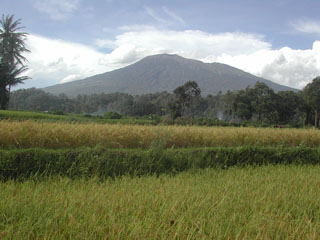Report on Marapi (Indonesia) — 15 May-21 May 2024
Smithsonian Institution / US Geological Survey
Weekly Volcanic Activity Report, 15 May-21 May 2024
Managing Editor: Sally Sennert.
Please cite this report as:
Global Volcanism Program, 2024. Report on Marapi (Indonesia) (Sennert, S, ed.). Weekly Volcanic Activity Report, 15 May-21 May 2024. Smithsonian Institution and US Geological Survey.
Marapi
Indonesia
0.38°S, 100.474°E; summit elev. 2885 m
All times are local (unless otherwise noted)
PVMBG reported that eruptive activity at Marapi (on Sumatra) was ongoing during 15-21 May. White gas-and-steam plumes rose 200-300 m above the summit and drifted in multiple directions on most days; no emissions were visible on 16 and 20 May. White-and-gray ash plumes rose 400-550 above the summit and drifted NW on 18 May.
The 11 May lahars that caused several fatalities, evacuations, and widespread damage in the Agam Regency continued to impact the area. As of 1700 on 16 May BNBP reported that the death toll had reached 67 people, while 20 remained missing and 40-44 had been injured; overall 989 families were impacted by the lahars. The Alert Level remained at 3 (on a scale of 1-4), and the public was warned to stay 4.5 km away from the active crater.
Geological Summary. Gunung Marapi, not to be confused with the better-known Merapi volcano on Java, is Sumatra's most active volcano. This massive complex stratovolcano rises 2,000 m above the Bukittinggi Plain in the Padang Highlands. A broad summit contains multiple partially overlapping summit craters constructed within the small 1.4-km-wide Bancah caldera. The summit craters are located along an ENE-WSW line, with volcanism migrating to the west. More than 50 eruptions, typically consisting of small-to-moderate explosive activity, have been recorded since the end of the 18th century; no lava flows outside the summit craters have been reported in historical time.
Sources: Pusat Vulkanologi dan Mitigasi Bencana Geologi (PVMBG, also known as CVGHM), Badan Nacional Penanggulangan Bencana (BNPB)

